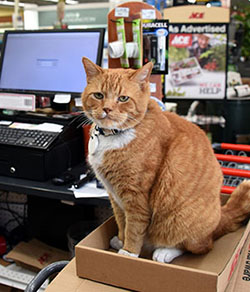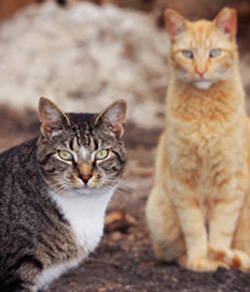BARC ANIMAL SHELTER AND ADOPTIONS
About Working Cats
While an adorable thought, Working Cats are not cats with tiny briefcases and ties. BARC often receives cats that do not fit the traditional adoption candidate mold. Some cats come to BARC with histories and temperaments that make them better suited for a more independent lifestyle. Working cats tend to fall into one of two categories:
 Stray or indoor/outdoor cats who have had some experience with humans and have developed a reliance on humans through limited contact, such as feeding, and are unsuitable for released through “Shelter Neuter Return”.
Stray or indoor/outdoor cats who have had some experience with humans and have developed a reliance on humans through limited contact, such as feeding, and are unsuitable for released through “Shelter Neuter Return”.- Cats who have lived indoors but have never been well socialized with humans. These cats are shy/fearful of new people and may prefer the company of other cats.
Our working cats can flourish while helping to control pest populations in places such as warehouses, barns, factories, plant nurseries, churches, police stations, free-standing commercial buildings, or any other property suited for independent-minded cats. Adopting out these types of cats to caring owners for use as Working Cats can provide the cats with a “job” and a better quality of life. The cats who are part of our Working Cat program are cats who in the past would not have had an outcome in the shelter, but thanks to this life saving program, we are able to find more homes for our feline friends than ever before!
What to Expect from a Working Cat
Working Cats have extensive resumes in effective, natural pest control. While they will not necessarily hunt down rodents, they will be very effective in deterring any possible rodents from entering their home. Working cats will still need to be provided with food, appropriate shelter, and medical care if the need arises.
How Do I Adopt a Working Cat?
 Our Working Cats are ready to jump into the workforce as soon as possible and there is no adoption fee to adopt a Working Cat. To begin, simply visit BARC and meet the cats who are part of this wonderful program. Once you select your new Natural Pest Deterrent Specialist, you will fill out a simple application. All working cats are vaccinated, spayed or neutered, microchipped, and ear-tipped before going to their new job assignments. We recommend bringing your own crate for transport.
Our Working Cats are ready to jump into the workforce as soon as possible and there is no adoption fee to adopt a Working Cat. To begin, simply visit BARC and meet the cats who are part of this wonderful program. Once you select your new Natural Pest Deterrent Specialist, you will fill out a simple application. All working cats are vaccinated, spayed or neutered, microchipped, and ear-tipped before going to their new job assignments. We recommend bringing your own crate for transport.
How Do I Acclimate My New Hire?
Because Working Cats are not your average house cat, they will need some special accommodations to make them successful in their new job! Bringing a Working Cat home won’t be as easy as opening the door of your cat’s carrier and allowing them free range of their new space. If not allowed a proper acclimation period, they can quickly leave and not return. The good news is that Working Cats usually adapt very well to their new surroundings when given an adjustment period in their new space. BARC recommends an adjustment period of 2-3 weeks minimum.
 Your new Working Cat will need an escape-proof place to spend their time during this adjustment period. This can be a secure room, porch, or large dog crate. We recommend this area also be used as the “home base” for your new cat, so take a little time to decide and choose the area wisely, keeping in mind that it will need to be accessible for cleaning and changing food or water! A litter box, food, water, and a safe hiding space (like a cardboard box) should be provided for your Working Cat in their acclimation area.
Your new Working Cat will need an escape-proof place to spend their time during this adjustment period. This can be a secure room, porch, or large dog crate. We recommend this area also be used as the “home base” for your new cat, so take a little time to decide and choose the area wisely, keeping in mind that it will need to be accessible for cleaning and changing food or water! A litter box, food, water, and a safe hiding space (like a cardboard box) should be provided for your Working Cat in their acclimation area.
During this period your job will be to teach your Working Cat where it is that they will be receiving their paycheck, aka FOOD! This is the “home base” and will be the place your Working Cat will return daily for food in the future. Establish a schedule with your cat and set meal times. We recommend using wet food during the acclimation period as it is most desirable by most cats. Combine feeding time with an audible cue such as kissing sounds, or saying “here, kitty-kitty”. This will help your cat better adjust to his new feeding schedule as well as associate your voice and presence with yummy food and treats.
After the acclimation period, you may leave the crate door (or the door of the secure room) open. Do not be alarmed if your cat darts off as they may just be very excited to be released. Leave the crate set up (or the door open of the secure room) so they have a familiar, safe place to return to if needed. Continue to fill their food and water bowls inside the crate or room during their explorations, while using the same audible cue you established during the acclimation period.
How Many Working Cats Should I Hire?
 Each job site’s needs and environment may vary but as a general recommendation, Working Cats are often found to do best in pairs or even groups of three or more, though some felines may prefer to work alone. We recommend using your best judgement and consider these factors when choosing how many Working Cats to hire! If you have questions, you can always refer to a BARC team member to help you decide!
Each job site’s needs and environment may vary but as a general recommendation, Working Cats are often found to do best in pairs or even groups of three or more, though some felines may prefer to work alone. We recommend using your best judgement and consider these factors when choosing how many Working Cats to hire! If you have questions, you can always refer to a BARC team member to help you decide!




